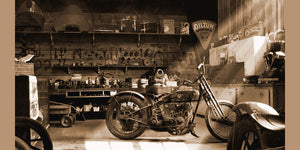Release Performance with Premium Motox Parts NZ Available Here
Release Performance with Premium Motox Parts NZ Available Here
Blog Article
Comprehending the Important Components of a Motorbike: A Comprehensive Guide for Fanatics
For bike lovers looking to elevate their riding experience and guarantee their bikes run efficiently, understanding the important components of a motorcycle is critical. Each aspect, from the engine's intricate operations to the essential duty of the braking systems, not only affects efficiency but additionally safety and comfort.
Engine Components

The camshaft plays a vital function in regulating the timing of the engine's valves, making sure the specific opening and closing necessary for efficient gas and air intake, in addition to exhaust expulsion. This timing is critical to preserving ideal engine efficiency and effectiveness. Additionally, the carburetor or fuel shot system, relying on the motorcycle design, is in charge of blending air with gas in the appropriate ratio for combustion.
The cooling system, either air or liquid-based, works to keep the engine's temperature within functional limitations, avoiding overheating and making sure durability - motocross parts nz. Each part, thoroughly designed and incorporated, adds to the seamless procedure of the engine, defining the bike's power result and general performance
Transmission System
Indispensable to the motorbike's performance, the transmission system ensures efficient power transfer from the engine to the wheels. This system comprises several critical components, consisting of the clutch, gearbox, and last drive, each playing an important function in equating the engine's power into activity. The clutch, usually operated by a hand lever, offers to involve and disengage the engine from the transmission, permitting smooth gear adjustments and regulated acceleration.
The transmission, often referred to as the transmission appropriate, contains a set of equipments that motorcyclists can by hand change with to change the bike's rate and torque result. These equipments are prepared in a sequence that allows the bike to increase smoothly and keep optimum engine efficiency across numerous speeds. Many motorbikes use a consecutive transmission, calling for the motorcyclist to move gears in an established order.
Braking Mechanisms
While understanding the transmission system is essential to harnessing a motorbike's power, just as crucial is the capability to regulate and stop that power properly, which is where stopping devices enter into play. Brakes are vital for safety and security and efficiency, offering the biker with the necessary control to navigate numerous surfaces and problems. Generally, bikes include two kinds of stopping systems: disc brakes and drum brakes.
Disc brakes are more widespread in modern motorcycles as a result of their premium efficiency. They consist of a brake disc, caliper, and pads. When turned on, the caliper squeezes the brake pads against the spinning disc, transforming kinetic power right into warmth, consequently slowing down the wheel. This system uses much better warm dissipation, constant performance, and boosted quiting power, specifically in damp problems.
Alternatively, drum brakes, though much less typical, are still found in some motorbikes. They function by pushing brake footwear against the internal surface of a drum affixed to the wheel. While usually less efficient in warmth dissipation and quiting power, drum brakes are simpler and much more economical.
Comprehending these braking systems' nuances enables riders to preserve their motorbikes properly and value the engineering that makes certain safe and efficient stopping.
Suspension and Guiding
Suspension and guiding systems are vital parts that dramatically influence a motorcycle's handling and experience comfort. The suspension system, consisting of forks at the front and shock absorbers at the rear, absorbs road irregularities, improving security and control. Front forks, commonly telescopic or upside linked here down, compress and rebound to alleviate impacts, while back shock absorbers keep tire call with the roadway, important for traction and safety.
Guiding, centered around the handlebars, links the motorcyclist to the bike's directional control. The guiding head bearings guarantee smooth operation, allowing accurate ability to move. Appropriate positioning and maintenance of these bearings are vital for foreseeable steering action and minimizing motorcyclist fatigue.
The suspension's adjustability is one more vital facet; preload, damping, and rebound settings allow modification to fit various riding problems and styles. This versatility is important for optimizing performance, whether browsing urban roads or dealing with sturdy trails. Advancements like digital suspension systems offer real-time adjustments, boosting adventure top quality throughout diverse surfaces.

Electrical Equipments
After ensuring a regulated and smooth trip through reliable suspension and steering systems, focus transforms to the electrical systems, a crucial aspect of contemporary motorcycles. These systems play a critical role not just in beginning the engine but additionally in powering various elements that boost the functionality and security of the bike.
At the heart of a bike's electrical system is the battery, which shops electric power essential for starting the engine and powering supporting systems - motocross gear. The alternator or generator, coupled with the rectifier-regulator, ensures the battery stays billed while the motorcycle functions, transforming mechanical energy right into electric energy and maintaining voltage levels
The ignition system, an additional critical part, is accountable for firing up the air-fuel combination in the engine's cyndrical tubes. Modern bikes frequently utilize a digital ignition system, supplying better effectiveness and reliability compared to traditional systems.
Lighting systems, consisting of fronts lights, tail lights, and indicators, are also vital, ensuring visibility and safety for the dirt bike hitch biker. Extra electronic parts such as sensing units, control devices, and presents add to advanced features like gas visit this page shot administration, anti-lock braking systems (ABS), and electronic control panels, additionally improving the riding experience.
Conclusion
A comprehensive understanding of a motorcycle's essential parts, consisting of the engine, transmission system, braking mechanisms, suspension, steering, and electrical systems, is important for enthusiasts intending to optimize safety, comfort, and performance. Proficiency of these aspects enables notified decisions relating to maintenance and upgrades, inevitably improving the riding experience. By incorporating this knowledge, motorcyclists can ensure their bikes run at peak performance and dependability, consequently optimizing both enjoyment and durability of their cars.
For motorbike lovers looking to elevate their riding experience and guarantee their bikes run smoothly, recognizing the crucial parts of a motorcycle is paramount.Integral to the motorbike's capability, the transmission system makes certain efficient power transfer from the engine to the wheels.While understanding the transmission system is key to utilizing a motorbike's power, similarly vital is the capacity to control and stop that power effectively, which is where braking mechanisms come right into play. Typically, motorcycles feature two types of braking systems: disc brakes and drum brakes.
A complete understanding of a motorbike's necessary components, consisting of the engine, transmission system, braking devices, suspension, guiding, and electrical systems, is essential for lovers aiming to enhance safety and security, comfort, and efficiency.
Report this page